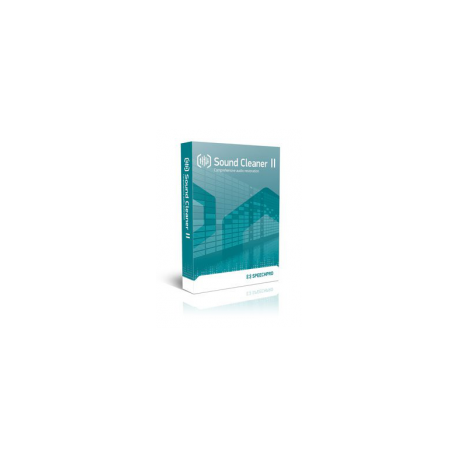Sound Cleaner II
New product
Software Sound Cleaner II Is a noise cleaning system. Through So
Software Sound Cleaner II Is a noise cleaning system. Through Sound Cleaner II The user can create a signal processing circuit by combining any of the provided filters in the sequence that he needs. Sound Cleaner II Provides users with a number of editing and signal processing tools that often precede the process of noise reduction. Besides, Sound Cleaner II Contains a built-in text editor that makes it possible to make a fast transcription of audio recordings without permanent transitions from the playback mode to a third-party text editor. The main features of Sound Cleaner II:
- Normalization of the signal before applying filters. Sound Cleaner allows you to normalize the sound by setting the desired output signal amplitude in counts or dB. In addition, negative and positive amplitude values can be adjusted separately.
- Clipping the signal in order to reduce the level of unwanted amplitude jumps and to reduce the effect of masking the signal.
- Resampling. If only the speech is of interest to the listener of the listener, a lowering of the sampling frequency will make it possible to get rid of high-frequency non-speech information, which can only interfere. Increasing the sampling frequency of the signal can be prepared for recording on a CD or broadcasting on air.
- Tempocorrection. Tempo correction allows you to increase or decrease the speed of speech without changing the tone. Fast speech can become more understandable if you slow down the playback speed of an audio recording.
- Stereo / mono operation. Splitting a stereo track into two mono channels will help avoid unnecessary processing of both channels.
- Broadband filter
- Tonal filter
- Dynamic filter
- The dynamic processing filter is designed to improve speech intelligibility in conditions of large signal level fluctuations. Dynamic processing algorithms improve the perception of sound by equalizing the amplitude of the signal on the audio record. A useful property of dynamic processing is to reduce the listener's fatigue.
- The dynamic processing filter is designed to improve speech intelligibility in conditions of large signal level fluctuations. Dynamic processing algorithms improve the perception of sound by equalizing the amplitude of the signal on the audio record. A useful property of dynamic processing is to reduce the listener's fatigue.
- The dynamic processing filter is designed to improve speech intelligibility in conditions of large signal level fluctuations. Dynamic processing algorithms improve the perception of sound by equalizing the amplitude of the signal on the audio record. A useful property of dynamic processing is to reduce the listener's fatigue.
- The dynamic processing filter is designed to improve speech intelligibility in conditions of large signal level fluctuations. Dynamic processing algorithms improve the perception of sound by equalizing the amplitude of the signal on the audio record. A useful property of dynamic processing is to reduce the listener's fatigue.
- The dynamic processing filter is designed to improve speech intelligibility in conditions of large signal level fluctuations. Dynamic processing algorithms improve the perception of sound by equalizing the amplitude of the signal on the audio record. A useful property of dynamic processing is to reduce the listener's fatigue.
- The dynamic processing filter is designed to improve speech intelligibility in conditions of large signal level fluctuations. Dynamic processing algorithms improve the perception of sound by equalizing the amplitude of the signal on the audio record. A useful property of dynamic processing is to reduce the listener's fatigue.
- The dynamic processing filter is designed to improve speech intelligibility in conditions of large signal level fluctuations. Dynamic processing algorithms improve the perception of sound by equalizing the amplitude of the signal on the audio record. A useful property of dynamic processing is to reduce the listener's fatigue.
- The dynamic processing filter is designed to improve speech intelligibility in conditions of large signal level fluctuations. Dynamic processing algorithms improve the perception of sound by equalizing the amplitude of the signal on the audio record. A useful property of dynamic processing is to reduce the listener's fatigue.







.jpg)




































